
SEMrush is undoubtedly a robust software, and its broad range of paid and organic functionality has made it one of the leading digital marketing tools. However, for a few reasons, many marketers are still searching for an SEMrush alternative.
In some cases, this is due to affordability. The full functionality of SEMrush is more expensive than many of its competitors. But you might also want a simpler solution that focuses on your specific function or a cleaner interface without a multitude of tools that feel like overkill for your business or agency.
Also, many marketers like to use a variety of tools in their research — to dive deeper into a particular campaign or competitor — or to cross-reference data. In this scenario, trying new software can give you a fresh perspective. But whatever the reason for your search, there are plenty of SEMrush alternatives you can test. In this article, we’re going to list the best SEMrush alternatives for:
- In-depth PPC analysis
- Digital marketing reporting
- Backlink analysis
- SEO keyword research
- Content marketing strategy
- Social media and brand monitoring
Hopefully, after seeing the options we lay out in this guide, you’ll be able to find the best SEMrush alternatives for your business — to match the functionality you need most.
Digging Deep into PPC Analysis? Try iSpionage
Both SEMrush and iSpionage uncover PPC data to strengthen the basis for your paid search advertising strategy. iSpionage, however, was created with a dedicated focus on paid search, so it offers more extensive and specialized features in this area than SEMrush.
In the Competitor Research Section, iSpionage gives you all the tools you need to understand the broad competitive PPC landscape. If you type in a competitor’s URL, you’re able to pull up information about their keywords, ads, ad copy, and landing page designs.
You can also search by keyword to figure out which competitors are targeting which keywords, see their ad copy, landing pages, and estimated monthly budget.
(Keep in mind: all of the images in this post are clickable so that you can get a better look at everything.)
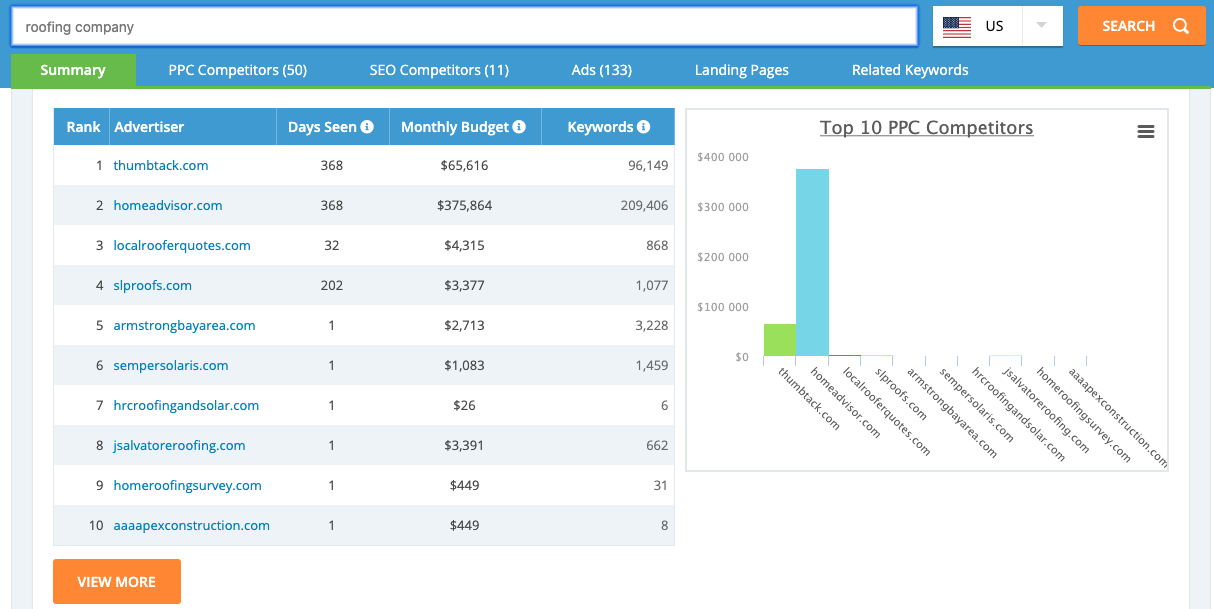
iSpionage also offers two proprietary metrics to help you understand the profitability and effectiveness of competitor campaigns: the Keyword Effectiveness Index (KEI) & Ad Effectiveness Index (AEI) scores.
The Keyword Effectiveness Index (KEI) provides a quick snapshot of how effective a keyword is. This is calculated using the length of time an advertiser has been using the keyword (“Days Seen”), and how recently the keyword was last seen (“Last Seen”).

Combined, these two duration metrics are good indicators that a keyword is working in a marketing campaign. If a keyword has been used for a long time (something you can gauge from “Days Seen”) and it’s still being used (something you can gauge from “Last Seen”), that means it’s likely to be delivering results. Otherwise, your competitor wouldn’t be spending their budget on it.
The “Average Position” is also calculated into the KEI (a high position means it costs more money and is likely to be delivering results — because who spends their budget on a keyword that isn’t?)
The Ad Effectiveness Index (AEI) is similar to the Keyword Effectiveness Index (KEI) — except instead of measuring keyword effectiveness, it measures advert effectiveness. It’s calculated based on duration, recency, and average position, too.

iSpionage also has a feature called Campaign Watch. Campaign Watch lets you select certain competitors to monitor their campaign performance over time. It will even send you an alert that tells you when one of the competitors you’re watching changes their campaign. Campaign Watch also gives you the ability to track local PPC competitors — a feature which SEMrush doesn’t offer.
Note: Campaign Watch is available on our paid subscription, with a 30-day money-back guarantee.
There’s another important distinction between SEMrush and iSpionage — SEMrush only focuses on keywords and ads. In our User Journey Report, iSpionage takes you from keyword, to ad, to landing page — so you can examine the whole user journey from start to finish in a single dashboard.
Landing pages are an important element of PPC success, because they’re where the actual conversion takes place. So, it’s hard to conduct a thorough PPC analysis without taking landing pages into account:
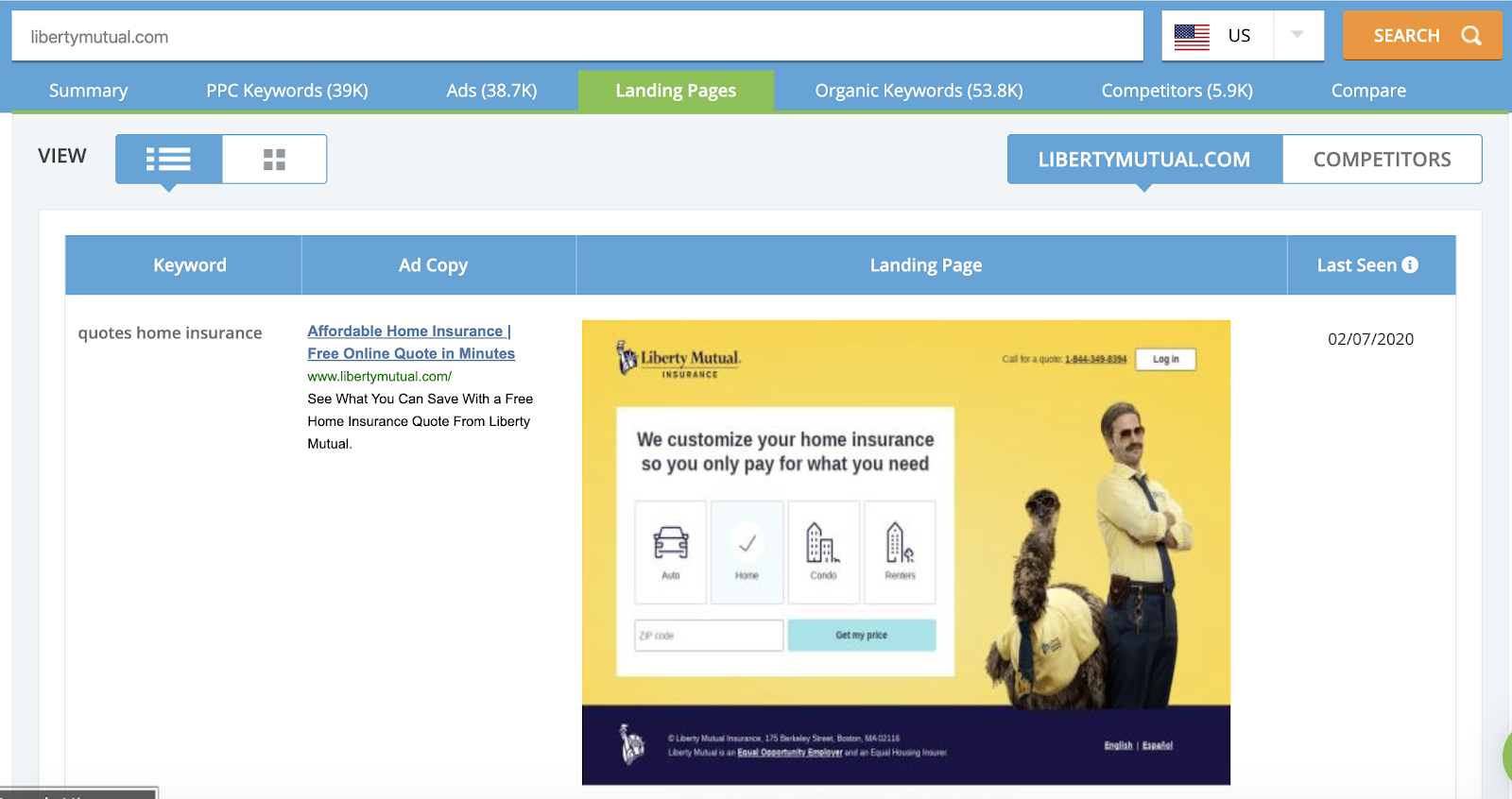
Our landing page display allows you to click through and analyze your competitors’ landing pages without having to spend time tracking them down manually.
Bottom line: iSpionage is a specialist PPC research tool, whereas SEMrush is more of a general digital marketing tool that covers multiple areas. iSpionage’s proprietary metrics help you better understand campaign profitability, and the window into your competitors’ landing pages helps you see the whole user experience and their journey to conversion.
Focusing on Reporting? Try Raven Tools
SEMrush has a “My Reports” tool that allows you to create SEO, competitor research, organic search, advertising research, Google Ads, and Google My Business reports. However, SEMrush’s $99 per month plan is limited to just 5 automated reports. If you’re looking for more, and some deeper report customization, you may want to try out Raven Tools.
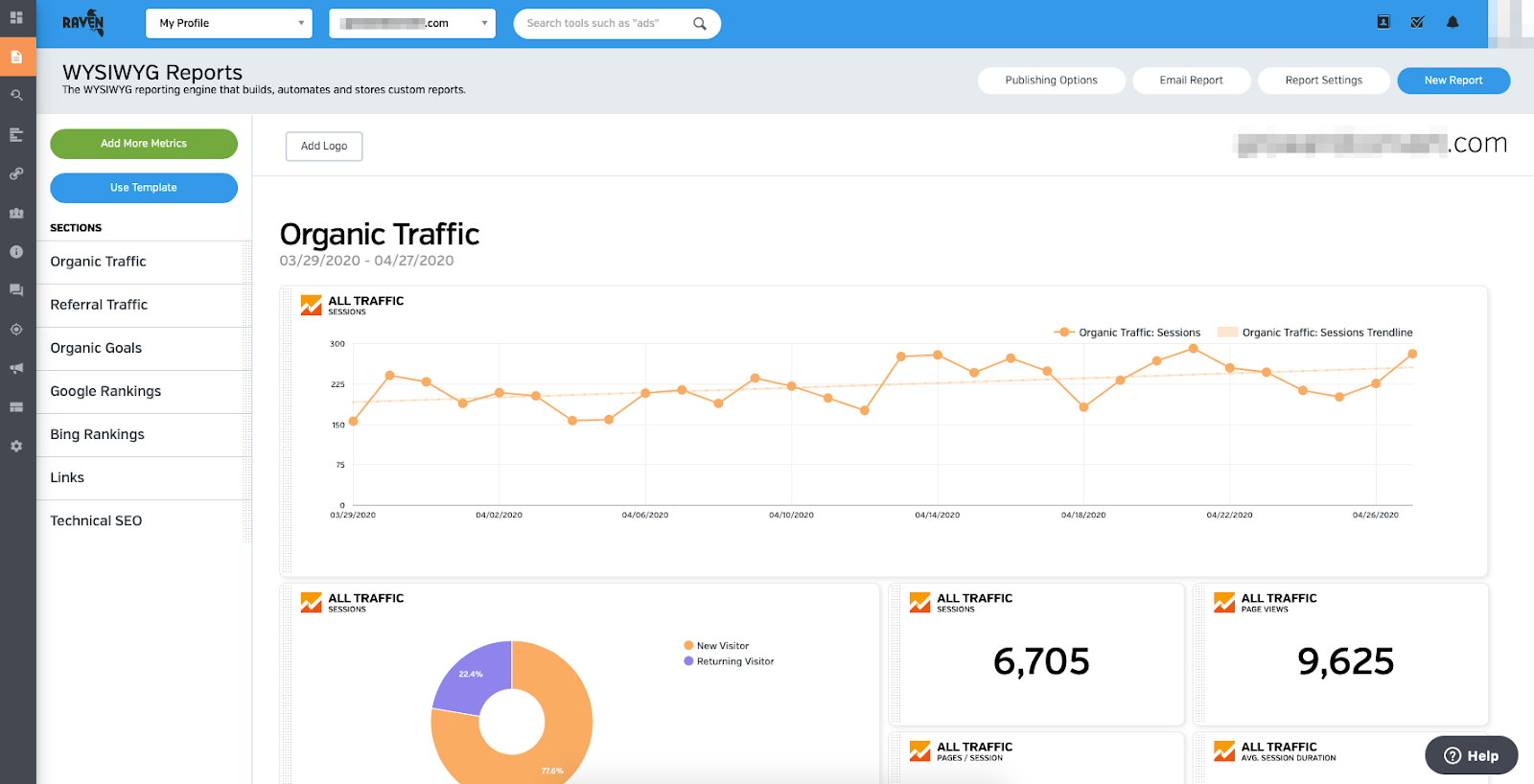
Raven Tools is an all-in-one platform for SEO research and reporting that helps you create custom marketing reports for each part of your marketing plan. All plans (which range in price from $39/month to $399/month) let you run unlimited automated reports. These reports include SEO reports to see your website rankings, authority, backlink profile, and organic traffic, as well as website analytics reports, social media reports, and PPC campaign reports.
In addition, Raven Tools has a “What You See Is What You Get” (WYSIWYG) report builder. This is a reporting tool that lets you create HTML and PDF reports from any data point in Raven. It allows you to pull organic ranking positions, social media data, CallRail reports, and other information into one automated daily, weekly, or monthly SEO report. In fact, you have access to 30+ data connections that can be brought into one dashboard.
With Raven, your reports can be white-labelled. This means you can create custom reports for your client’s most important key performance indicators (KPIs) with your own logo and branding. SEMrush only offers white label reports to those with a Business level ($399/month) subscription.
Bottom line: Both Raven Tools and SEMrush have extensive reporting capabilities, but Raven Tools offers far more reporting functionality for your money.
Need an Alternative Tool for Backlink Analysis? Try Ahrefs
SEMrush is an effective tool for backlink analysis, because as well as letting you view your backlink profile, it offers an audit tool that helps you spot links that Google might penalize you for. And there’s also the backlink competitors report, which lets you see domains with the most backlinks in common — so you can size up your competition.
Despite these features, you might be looking for an SEMrush alternative with similar clout. Ahrefs is known for having one, and its backlink index is updated every 15 minutes.
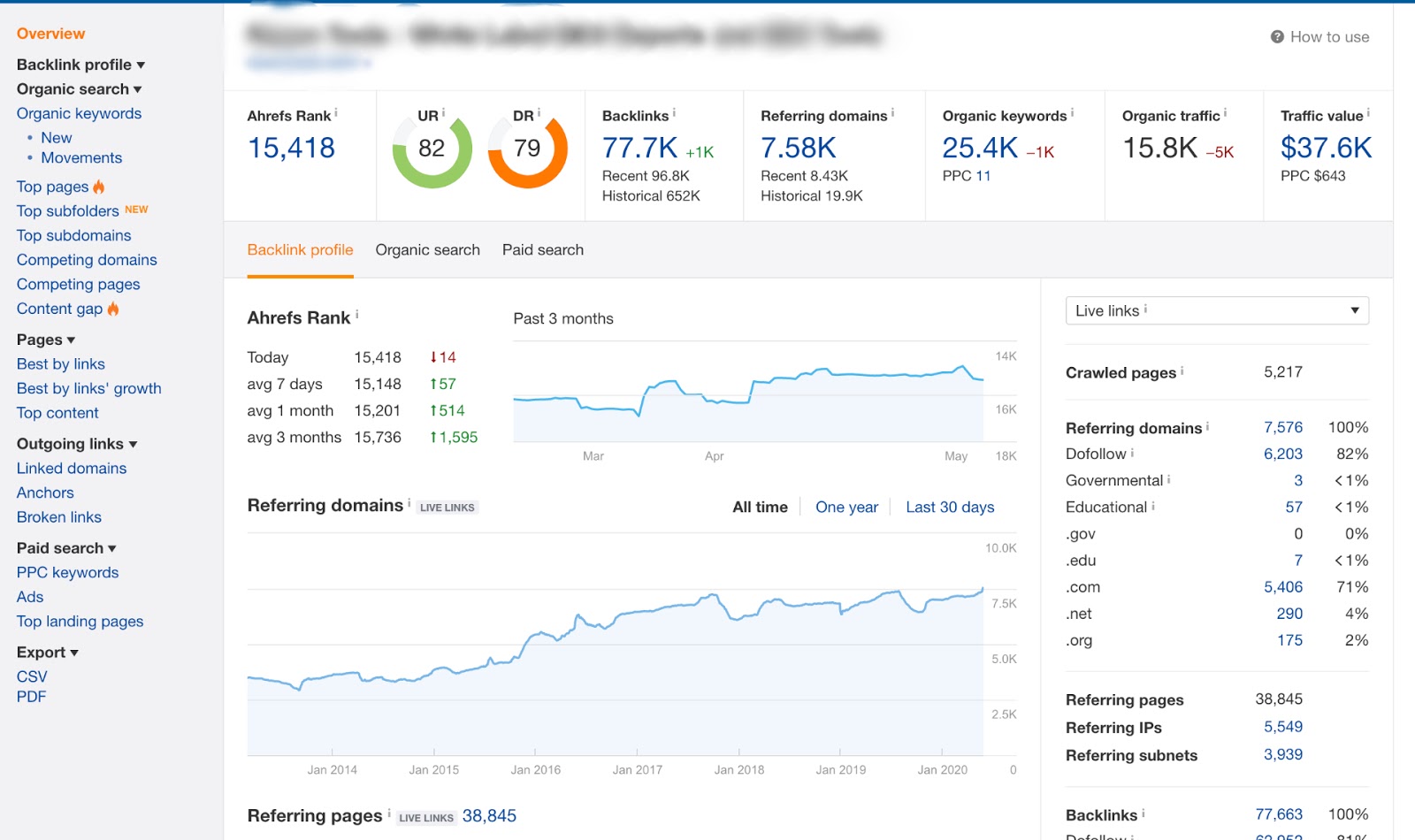
Ahrefs’ dashboard provides a view of referring domains and pages over a specific amount of time, so you can monitor backlink growth (or lack thereof). Its Domain Rating (DR) and URL Rating (UR) metrics help you gauge the number of backlinks (backlink strength) of any site.
Its backlinks report lets you see every page linking to the site you’re targeting. You can filter and sort this report by language, link type (“dofollow” / “nofollow”), platform, Domain Rating (DR), URL Rating (UR), and referring domains. It also shows estimated organic traffic to each linking page and referring domain.
Ahrefs’ referring domains report shows every linking domain, along with metrics like: Domain Rating (DR), Ahrefs Rank (AR), referring domains, linked domains, estimated organic traffic, and links to target. The “Best by links” report helps you research competitors’ pages that are linked to most often. You can use this to figure out what’s most linkworthy.
The linked domains report shows SEO metrics for outbound linked domains, including: Domain Rating (DR), Ahrefs Rank (AR), total followed referring domains, total followed linked domains, estimated organic traffic, number of links from the target (total and followed).
The broken links report lets you see a site’s broken outbound links. And the anchors report lets you see a site’s outbound linking anchor text, to give you a better idea how your competitors use anchor text to optimize their backlink profile.
Like SEMrush, Ahrefs is a tool that can come with a hefty price tag. The most basic package is currently $99 per month, which gives you access to a variety of features — but with upper limits on the amount of data you can access.
Bottom line: Both Ahrefs and SEMrush place strong emphasis on links, and Ahrefs is a worthy contender for SEMrush when it comes to backlink analysis.
Conducting Keyword Research? Try iSpionage’s SEO Features
SEMrush is known for its keyword research functionality, while iSpionage is known as a PPC-focused competitor research tool. But iSpionage also has powerful SEO competitor research capabilities that can uncover valuable keyword ideas for your content strategy.
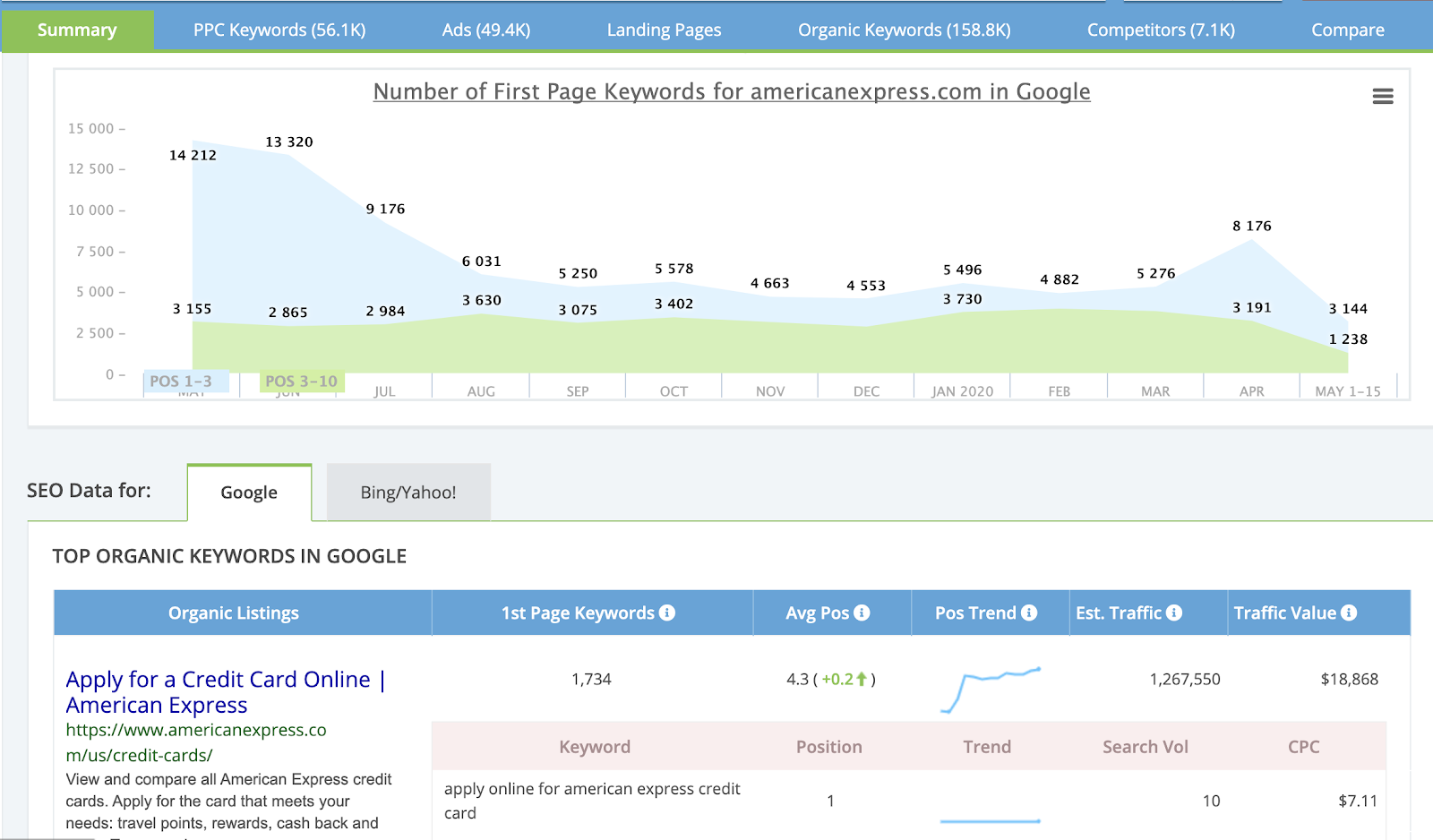
iSpionage’s SEO Competitor Research dashboard allows you to search by keyword to see which domains perform in the organic SERPs, and you can dig into the profile of each domain to find data on organic keywords, traffic volumes, traffic value, page performance, and ranking trends. Here you can learn which keywords are being targeted, and which content performs.
The SEO Watch feature in the Campaign Watch section shows up to 24 months of historical data about page performance and keyword rankings for competitors. It also includes localized SEO data, screenshots of the keyword SERPs, and a competitor benchmarking feature that allows you to compare competitors through a side-by-side graphical representation.

The SEO Share of Voice data lets you see the market reach of a site. You get a clear view of how much organic traffic competitors (and potential partners) are getting from your target keywords, so you can hone your content strategy to take this into account.
Bottom line: iSpionage doesn’t just give you a long list of keywords — it shows whether those keywords are driving traffic to your competitors’ websites, and which of their pages are performing best. While iSpionage has a reputation for uncovering PPC data, its SEO research features are also worth testing out if you’re looking for an SEMrush alternative.
Sign up for a free iSpionage account to access SEO competitor research. SEO Campaign Watch is available on paid subscription, with a 30-day money back guarantee.
Want Content Marketing Insights? Try BuzzSumo
SEMrush offers a variety of content marketing tools, but you only get full access if you’re signed up for their Guru ($199.95/month) or Business ($399.95/month) plans. If you need to research topics for content marketing, BuzzSumo may be a worthy SEMrush alternative (starting at $99/month).

BuzzSumo is a tool that allows you to search for topics in your niche and see which websites have the most engaging content. More specifically, BuzzSumo tells you what content is performing best in your niche on Facebook, Twitter, Pinterest, and Reddit.
BuzzSumo reports the number of backlinks, and shows something called the Evergreen Score, which measures engagement 30 days after a piece of content has been published. This metric is a good way to gauge an article’s longevity and relevance.
In addition to letting you browse popular content by topic or niche, BuzzSumo lets you search by competitor domain, so you can take an in-depth look at your competitors’ content strategy.
You can also filter by content type (if you’re looking for data on content in a specific format, like infographics, for example), word count, time frame, location, language, and other features. BuzzSumo has a monitoring feature that allows you to create alerts for when certain domains mention topics or keywords that you’re targeting in their content.
Bottom line: If refining the front-end of your content marketing strategy is your top priority, BuzzSumo could be the right SEMrush alternative for you.
Monitoring Social Media and Brand Reputation? Try Mention
SEMrush comes with a built-in brand monitoring tool that scans the internet for mentions of your brand (or your competitor’s). If this is one of the SEMrush features that currently gets the most use in your business, you might want to consider Mention as an alternative.
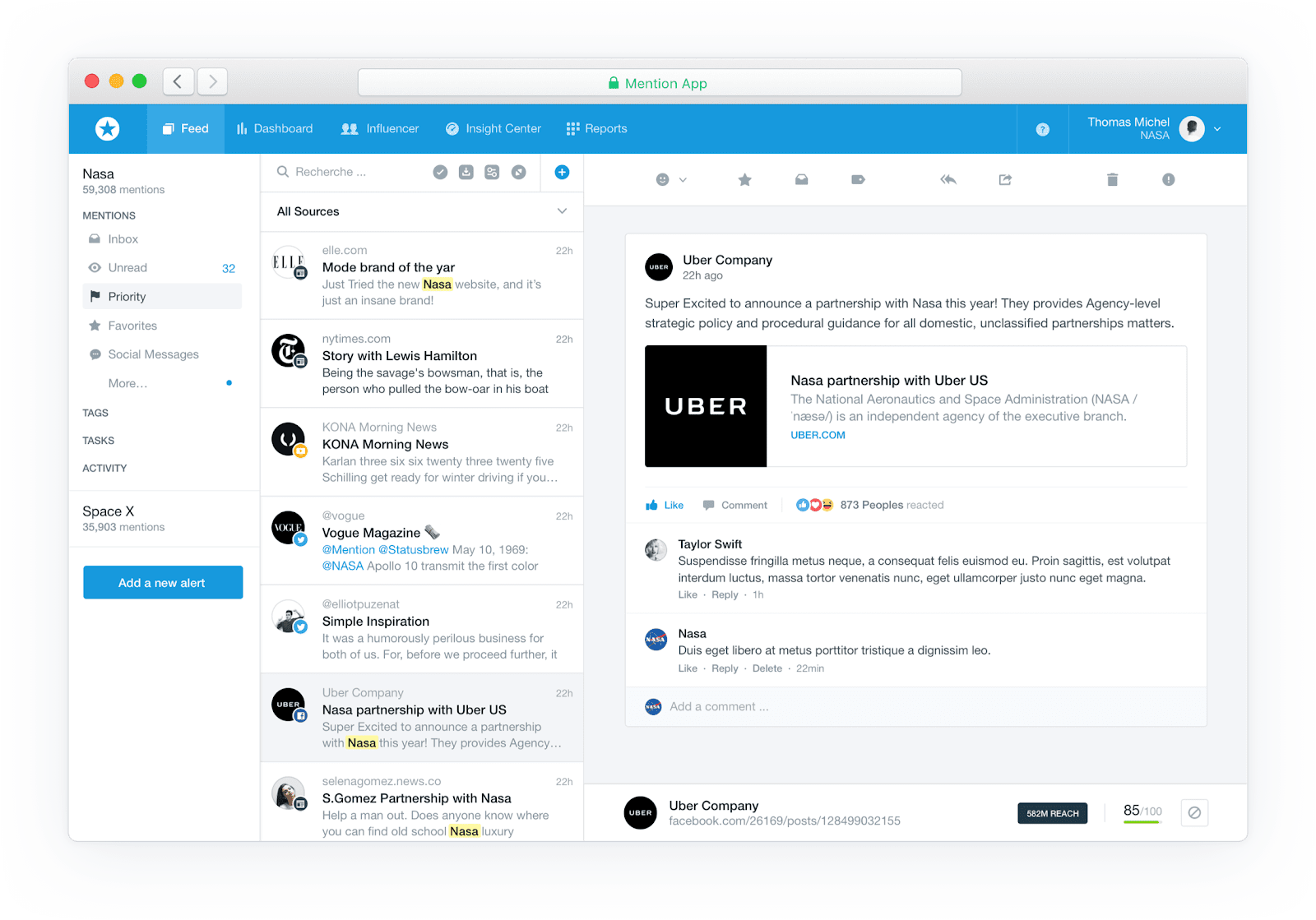
Mention is a tool that tracks brand mentions online and on social media. You can create alerts for multiple brands (your own and competitors), and Mention will track these brands on Facebook, Twitter, and Instagram. It will also track mentions on blogs, forums, and in news outlets.
Mention’s Insights Center allows you to analyze brand sentiment patterns, see volume trends of competitor mentions, and view their social reach. It also gives you insights into influencer marketing campaigns by allowing you to track influencers who mention your competitors.
Mention is highly-focused on one main area: social (and online) media monitoring, brand management, and social media management. It won’t handle any other aspects of your digital marketing — whereas iSpionage, Raven, Ahrefs and SEMrush provide PPC and SEO insights.
If you’re on the fence about whether Mention is right for you, you can test out its free version before you commit to a more comprehensive paid plan.
Bottom line: If you’re a brand-focused marketer or social media specialist, Mention is a credible alternative to SEMrush’s brand monitoring functionality.
Summary
SEMrush is a robust digital marketing tool built for a variety of digital marketing functions. When looking for an alternative, you may want to select a tool that focuses on the specific uses most relevant to your business. If you’re looking for actionable PPC and SEO data — especially in relation to competitors and the competitive landscape — iSpionage is a worthy contender and a great alternative to SEMrush.
Sign up for a free iSpionage account and get access to competitor keywords, ad copy, and landing pages. Receive 10 free competitor reports and 3 complimentary competitor alerts per day. For SEO & SEM Campaign Watch, sign up to a paid subscription with a 30-day money-back guarantee.
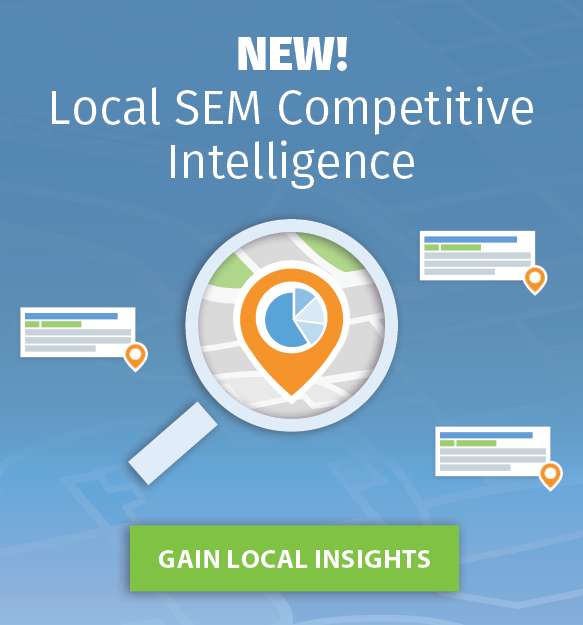










Comments are closed.